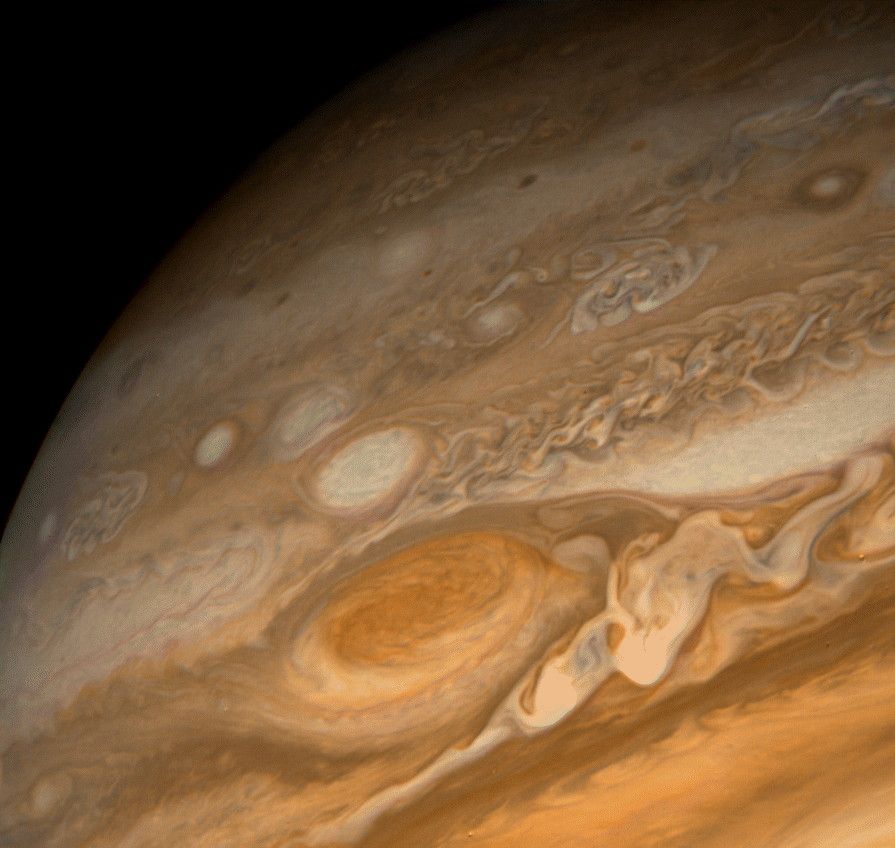
It's hard to imagine the sheer scale of Jupiter's Great Red Spot from here on Earth, because the storm is so big that it could swallow our planet.
Now, it turns out, the Great Red Spot isn't just wide: it's deep too, quite a bit deeper than anybody expected. Data from NASA's Juno spacecraft has shown that the behemoth storm extends as much as 310 miles (500 kilometers) beneath Jupiter's cloud tops. And the Jupiter maelstrom is linked to jets that go far deeper, hinting that the giant planet's upper and lower atmospheres are tied together.
These findings come thanks to two groups of scientists, who analyzed data gathered by two different Juno instruments.
Related: Photos of Jupiter's Great Red Spot, the solar system's biggest storm
One group measured the Great Red Spot's gravity. It began as a simple idea: to turn Juno's Gravity Science instrument on the 10,000-mile-wide (16,000 km) storm, in order to see if it left behind any fingerprints on Jupiter's gravitational field.
"This wasn't part of the original Juno proposal," said Marzia Parisi, a scientist at NASA's Jet Propulsion Laboratory in Southern California, who led the study that reported the gravity results.
Using gravity measurements to investigate atmospheric phenomena isn't new; it's been done on Earth, for instance, by the twin satellites of NASA's GRACE ("Gravity Recovery and Climate Experiment") mission. Gravity instruments can also see deeper into the atmosphere than other instruments tend to see. This just had never been done with the Great Red Spot.
But even after the idea was approved, Parisi and her colleagues had no idea if they would actually find anything. The Great Red Spot might be a colossus, but it's a drop in the bucket of Jupiter's total mass. And, Parisi said, "if you don't know how deep the Great Red Spot is, you can't predict what you're going to see."
But the researchers did indeed pick up fluctuations in Jupiter's gravitational field, enough for them to get a handle on the storm's depth: 310 miles (500 km), taller than the distance from sea level to the International Space Station. And the great storm seems to be fed by jets that reach down far deeper — as much as 1,900 miles (3,000 km), the team found.
At the same time, a different group was studying the Great Red Spot with Juno's Microwave Radiometer, an instrument that probes the planet's atmosphere with microwaves. These scientists wanted to look deep into the storm to see how it ticked, vertically.
They found that the Spot, along with several other storms on Jupiter, stretches far down, with precipitation and drafts at unprecedented depths. They found signatures of these phenomena below Jupiter's cloud level, beneath which the ammonia and water in the atmosphere are expected to condense.
Together, the gravity and microwave measurements hint that Jupiter's upper atmosphere is meaningfully connected to these depths.
Related stories:
Juno has been making long, looping orbits around Jupiter since 2016, and NASA recently extended its mission until 2025. Soon, if all goes according to plan, Juno's orbital path will move to take the probe over the planet's north pole — and away from the Great Red Spot, which is farther south. But, according to Parisi, Juno's instruments will get the chance to watch other curiosities, such as Jupiter's cryptic polar cyclones.
"And then we have the moons," said Parisi. "We flew by Ganymede already, and we're going to do that for Europa and Io. They're obviously going to collect data there as well."
Both of the new studies were published online today (Oct. 28) in the journal Science. You can find them here and here.
Follow us on Twitter @Spacedotcom and on Facebook.
"had" - Google News
October 29, 2021 at 01:14AM
https://ift.tt/3BpMDiq
Jupiter's Great Red Spot is even deeper than scientists had thought - Space.com
"had" - Google News
https://ift.tt/2KUBsq7
https://ift.tt/3c5pd6c
Bagikan Berita Ini














0 Response to "Jupiter's Great Red Spot is even deeper than scientists had thought - Space.com"
Post a Comment